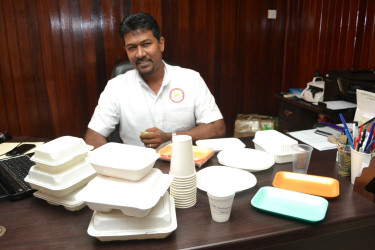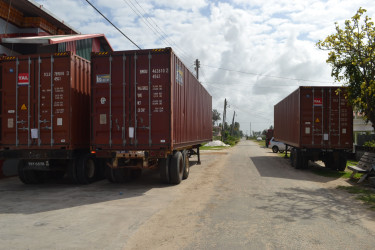What appears to be evidence of significantly higher costs for biodegradable food containers is likely to impact on the widely popular take-away and street vending food culture with indications pointing to a likely knock-on rise in food prices.

While there is already a bewildering array of ‘biodegradables’ to choose from, Stabroek Business has already identified a particular type already in use at some eating houses and has been able to determine that prices, in some instances, are as much as 50 per cent higher for the biodegradable ones. Currently, three-compartment Styrofoam food boxes are available on the market at $3,500 per bale of 200 with the container being retailed at $17.50 each. The one-compartment Styrofoam container is being sold at $2,500 per bale of 200 and retailed at $12 each while the burger-size container is available at $2,400 per bale of 200 and $12 each. By comparison, the respective prices of the biodegradable containers currently in limited use are $8,000 and $40; $5,500 and $27.50 and $5,000.00 and $25. Price rise predictions for take-aways once the new receptacles kick-in range between $100 and $200.
Beyond that, evidence is emerging that the eventual transition from the much-maligned Styrofoam food and beverage containers to biodegradable replacements will probably not be as uneventful as the Government of Guyana might hope. While the authorities here are hoping to turn the lights out on the containers which, over the years, have been a boon for food vendors but one of the country’s worst environmental nightmares, challenges persist.
The present government, by announcing late last year that it was forbidding the use of styrofoam containers from January 1 this year, was hoping to outdo its predecessor which despite at least two promises to do so since 2012, departed office leaving the containers in service. The containers had endured years of opprobrium every time, carelessly discarded, they ‘ganged up’ to clog waterways and compound floods in the city.
It appears, however, that the present government is itself finding out that getting rid of Styrofoam receptacles is not as easy as was first taught. Two weeks ago it announced that it would allow three months for existing stocks of the containers and stocks currently on order to be disposed of before the ban finally comes into place. No one seems entirely sure as to the extent of the inventory of Styrofoam containers remaining in the system. What is known is that the widely popular containers are customarily ordered in huge quantities. The question is, when will those stocks be exhausted?
Equivalent

Rajkumar Outar, the proprietor of Atlantic Southern Trades Inc. and one of about twelve importers of styrofoam containers is concerned. At his Annandale, East Coast Demerara storage bond he is currently holding the equivalent of fifteen 40-ft containers of Styrofoam receptacles. In theory, he now has a few days less than three months to dispose of them and he doubts that he can do so. The announcement of the January 1, 2016 ban on the containers had put a brake on the volume of orders or else, had resulted in the cancellation of existing orders. There is, it seems, a mindfulness of the official warning of a fine being imposed on businesses found using styrofoam containers.
And while this newspaper was unable to determine the volume of stock being held by other importers we are aware too that significant stocks are on hand. N&S Mattai, another major importer of Styrofoam containers, is also holding stocks of the receptacles.
Outar, whose key customers include Royal Castle, Bounty and several Chinese restaurants, told Stabroek Business that customarily, sales of Styrofoam containers increase by around 40 per cent so that importers make their end-of-year orders as early as August. What this means is that significant stocks would have been imported before and possibly after the official announcement of the ban was made. The abrupt falloff of local purchases means that the businessman is left with large volumes of ‘dead stock.’
Outar says his suppliers in the Dominican Republic are similarly concerned. Guyana’s banning of Styrofoam containers, it appears, coincides with a similar ban imposed by Haiti, the Dominican Republic’s next door neighbour.
The extension of the deadline for the banning of Styrofoam containers is reportedly a response to the significant lobby from the food industry that includes a small but influential Chinese restaurant industry and a growing clutch of coastal fast food outlets. The smaller players are worried too. Orson Mingo, a South Georgetown roadside vendor who also offers a bi-weekly barbecue service says that consumers who have a preference for take-away food can anticipate a price hike once the ban on the use of Styrofoam containers kicks in fully. He is worried, pointing out that the disposable income of his client base is insufficient to accommodate a price increase for the nightly dinners that he offers.
There may be other bridges to cross too. Outar says that unless the three-month deadline for the disposal of in-stock Styrofoam containers is extended, importers are likely to lose millions of dollars having been left to hold what will effectively be useless stock.
Outar is also holding stocks of biodegradable food containers which he says can be purchased from China and India. This newspaper senses, however, that business houses are awaiting a measure of guidance from state entities like the Environmental Protection Agency. It appears that there could well be difficulties associated with which imported containers actually qualify as biodegradable.









